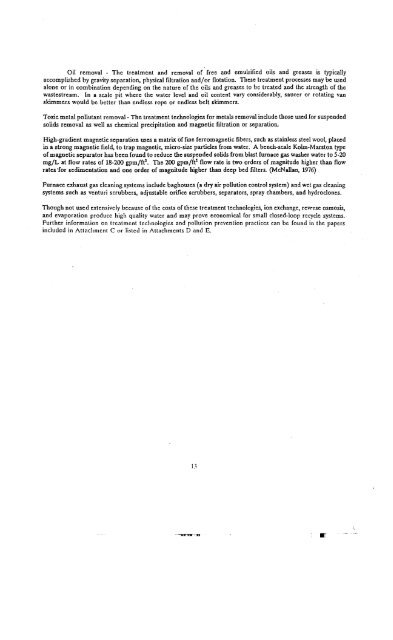Watcr Q!!alit\1 lmprovcmct1t at1() COf1scrvatiof1l'rojcct
Watcr Q!!alit\1 lmprovcmct1t at1() COf1scrvatiof1l'rojcct
Watcr Q!!alit\1 lmprovcmct1t at1() COf1scrvatiof1l'rojcct
Create successful ePaper yourself
Turn your PDF publications into a flip-book with our unique Google optimized e-Paper software.
Oil removal - The treatment and removal of free and emulsified oils and greases is typically<br />
accomplished by gravity separation, physical futration and/or notation. These treatment processes may be used<br />
alone or in combination depending on the nature of the oils and greases to be treated and the strength of the<br />
wastestream. In a scale pit where the water level and oil content vary considerably, saucer or rotating van<br />
skimmers would be betler than endless rope or endless belt &kimmers.<br />
Toxic metal pollutant removal- The treatment technologies for metals removal include those used for suspended<br />
solids removal as well as chemical precipitation and magnetic filtration or separation.<br />
High-gradient magnetic separation uses a matrix of fme ferromagnetic fibers, such as stainless steel wool, placed<br />
in a strong magnetic field, to trap magnetic, micro-size particles from water. A bench-scale Kolm-Marston type<br />
ofmagnetic separator has been found to reduce the suspended solids from blast furnace gas washer water to 5-20<br />
mg/L at now rates of 18-200 gpm/fe. The 200 gpm/fe now rate is two orders oC magnitude higher than now<br />
rates'for &edimentation and one order oC magnitude higher than deep bed fJlters. (McNallan, 1976)<br />
Furnace exhaust gas cleaning systems include baghouses (a dry air pollution control system) and wet gas cleaning<br />
systems such as venturi scrubbers, adjustable orifice &c:rubbers, separators, spray chambers, and hydroclones.<br />
Though not used extensively because of the cosls of these treatment technologies, ion exchange, revr-rse osmosis,<br />
and evaporation produce high quality water and may prove economical for small closed-loop recycle systems.<br />
Further information on treatment technologies and pollution prevention practices can bc found in the papers<br />
included in Attachment C or li~led in Attachments D and E.<br />
13

















